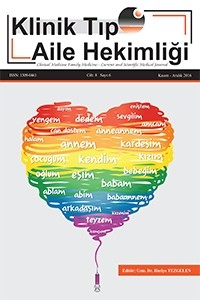Aile Hekimliği Polikliniğinde Hipofizer Gigantizm Tanısı Konulan Bir Olgu
Hipofizer adenom, gigantizm, sağlık raporu, aile hekimliği
A Case Diagnosed As Hypophyseal Gigantism On A Family Medicine Policlinic
Hypophyse adenom, gigantism, Health report, Family Medicine,
___
- Kaynaklar 1. Eugster EA, Pescovitz OH. Gigantism. J Clin Endocrinol Me-tab 1999; 84: 4379-84. 2. Epstein LH, Wing RR, Valoski A. Childhood obesity. PediatrClin North Am 1985; 32:363-79. 3. Whitehead EM, Shalet SM, Davies D, Enoch BA, Price DA,Beardwell CG. Pituitary gigantism: a disabling condition. ClinEndocrinol (Oxf) 1982; 17: 271-7. 4. Backeljauw PF, Dattani MT, Cohen P, Rosenfeld RG. Disor-ders of growth hormone/insulin-like growth factor secretionand action. In: Sperling MA (ed). Pediatric endocrinology. Ed4. Philadelphia, Saunders, pp 382-384. 5. Katznelson L, Atkinson JL, Cook DM, Ezzat SZ, HamrahianAH, Miller KK; AACE Acromegaly Task Force. American As-sociation of Clinical Endocrinologists Medical Guidelines forClinical Practice for the Diagnosis and Treatment of Acro-megaly--2011 update: executive summary. Endocr Pract2011; 17: 636-46. 6. Barkan AL, Beitins IZ, Kelch RP. Plasma insulin-like growthfactor-I/somatomedin-C in acromegaly: correlation with thedegree of growth hormone hypersecretion. J Clin EndocrinolMetab 1988; 67: 69-73. 7. Riedl S, Frisch H. Diagnosis of growth hormone excess andhyperprolactinemia. In: Ranke MB, Mullis P-E (eds). Diag-nostics of endocrine function in children and adolescents. ed4. Basel, Karger, 2011, pp 183–193. 8. Rhee N, Jeong K, Yang EM, Kim CJ. Gigantism caused bygrowth hormone secreting pituitary adenoma. Ann Pediatr En-docrinol Metab 2014; 19: 96-9. 9. Melmed S, Jackson I, Kleinberg D, Klibanski A. Current tre-atment guidelines for acromegaly. J Clin Endocrinol Metab1998; 83: 2646-52. 10. Abe T, Tara LA, Lüdecke DK. Growth hormone-secreting pi-tuitary adenomas in childhood and adolescence: features andresults of transnasal surgery. Neurosurgery 1999; 45: 1-10. 11. Andersen M. Management of endocrine disease: GH excess:diagnosis and medical therapy. Eur J Endocrinol 2013; 29:170:R31-41. 12. Vance ML. Pituitary adenoma: a clinician's perspective. En-docr Pract 2008; 14: 757-63. 13. Costin G. Endocrine disorders associated with tumors of thepituitary and hypothalamus. Pediatr Clin North Am 1979; 26:15-31.
- ISSN: 1309-0461
- Başlangıç: 2009
- Yayıncı: Selen Medya Yayıncılık Tanıtım ve Organizasyon Hizmetleri
Dövme Uygulamaları Ne Kadar Güvenli
Rekürrent Aftöz Stomatitli Olgularda Hemoglobin, Demir, Ferritin ve Vitamin B12 Düzeyleri
Olgularla Kulak Enfeksiyonları
İnsülin Tedavisi ve Hipoglisemi Üzerine Yapılan Çalışmalara Güncel Bakış
Kronik Böbrek Hastalığı Olan Çocuklarda Beslenme Desteği
Üniversitesi Öğrencilerinde Güneşten Korunma Bilinci (Toplumsal DuyarlılıkProjesi)
